
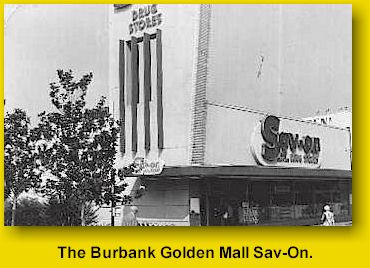 One of the Burbank haunts of my father and me on our Sunday drives, in addition to The Akron (a Sixties version of Pier One Imports), the Tally-Rand (a restaurant where I once got food poisoning) and Albin's Drugstore was the Sav-On drugstore in the Burbank Golden Mall. I could not predict, however, that a great teenage spiritual awakening would take root there.
One of the Burbank haunts of my father and me on our Sunday drives, in addition to The Akron (a Sixties version of Pier One Imports), the Tally-Rand (a restaurant where I once got food poisoning) and Albin's Drugstore was the Sav-On drugstore in the Burbank Golden Mall. I could not predict, however, that a great teenage spiritual awakening would take root there.
The idea behind the Golden Mall was to create a traffic-free pedestrian shopping area. So, the City of Burbank closed San Fernando Road to vehicles, added water fountains, playgrounds and odd geometrically-shaped structures in front of the stores and, in 1967, this bold new scheme was unfolded. In 1989, after the area had gone to seed, the structures were removed and traffic was once again allowed to pass. The problem was that the surrounding parking was too inconvenient for shoppers, who avoided the place. It was certainly inconvenient for my father, who always complained about having to walk from the surrounding parking areas to the mall. (He hated the picturesque San Pedro Ports of Call - based on a New England seaport village - for a somewhat different, but associated reason: walking on the olde tyme cobblestones hurt his feet.)
Sav-On was one of the anchor businesses of the Golden Mall, and I liked the place because they had great cherry vanilla ice cream. I recall the bombastic Sav-On radio jingle, sung by a virile men's choir: Sav-On!/Sav-On!/Blah, blah, blah/It's fun to serve yourself and save/Sav-On drugstore!/Sav-On drugstore!/(Tympani strokes) BOOM! BOOM!/SAV-ON! For some reason I always had a mental image of wild, bare-chested men singing this while brandishing mortars and pestles.
 One day, looking over the paperback spinner as was my wont, I noticed a book with an intriguing black cover. It was Eden Gray's A Complete Guide to the Tarot - which, by the way, is considered a classic and is still in print. I thumbed through it and found myself fascinated by the odd pictures from the famous Albino-Waite tarot deck. Even better, Gray's text not only described the various meaning of the cards ("disruption, reverses, misfortune, a change in affairs") but described them in language that suggested ancient and arcane symbology and meaning. When dad was ready to go I put the book aside, but the pictures stayed in my head - so much so that the following Sunday I insisted that we visit Sav-On again so that I could buy the book.
One day, looking over the paperback spinner as was my wont, I noticed a book with an intriguing black cover. It was Eden Gray's A Complete Guide to the Tarot - which, by the way, is considered a classic and is still in print. I thumbed through it and found myself fascinated by the odd pictures from the famous Albino-Waite tarot deck. Even better, Gray's text not only described the various meaning of the cards ("disruption, reverses, misfortune, a change in affairs") but described them in language that suggested ancient and arcane symbology and meaning. When dad was ready to go I put the book aside, but the pictures stayed in my head - so much so that the following Sunday I insisted that we visit Sav-On again so that I could buy the book.
I am unsure of exactly when this happened. I first met my dreamy gal pal Angela in 1968, and when we first met we spent a lot of time on the phone while she explained plot background of the horror soap opera Dark Shadows. One day, at home sick from school, I discovered this show on TV; my first episode was when the heavily-sideburned Quentin Collins, the werewolf, was introduced. Tarot cards were used in the show (Angela told me that Barnabas Collins' personal card was "the Magician"), and I think my telling Angela about Gray's book, discovering Dark Shadows and her superstitiously giving me her miniature pack of tarot cards (she and her mother were active Catholics) all happened at about the same time - so I was twelve or thirteen.
I took her miniature cards and starting memorizing the meanings of each (upright and reversed, or upside-down). One of the Holland girls - also a superstitious Catholic - gave me her full-sized pack. So I was prepared by instinct and enthusiasm to begin daily readings for myself. And right away I noticed something that has annoyed me about fortune-telling and astrology to this day.
I have always had the opinion that astrological readings and tarot spreads are mainly intended for single people who are unencumbered by a job or family, and for whom the world at large is one vast opportunity. As a nerdish thirteen year old it was difficult for me to accept the judgment of the cards that a voyage at sea might soon happen, or that a romance would soon blossom, or that a business opportunity might present itself. (Click here for a funny old New Yorker cartoon along these lines.) Nevertheless, under the spell of the occult designs and meanings of those mysterious, artsy cards, I persevered in my study.
In 1969 I designed myself a set of Star Trek-inspired cards using 3" x 5" index cards and colored pencils. Realizing the artistic possibilities of the interesting designs on what are called the "major arcana" (the first 22 cards in the tarot deck) I came up with the following designs that I can recall:
Major Arcana Card III - The Empress: Lieutenant Uhura
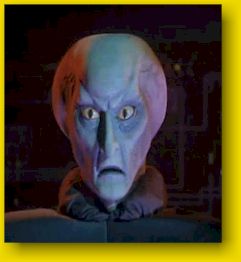 Major Arcana Card IV - The Emperor: Captain James T. Kirk
Major Arcana Card IV - The Emperor: Captain James T. Kirk
Major Arcana Card VII - The Chariot: The Starship Enterprise (naturally).
Major Arcana Card XIII - Death (my favorite): A skeleton in a space suit, aimlessly drifting through space in the manner of the astronaut cast adrift in 2001 - A Space Odyssey.
 Major Arcana Card XV - The Devil: The scary alien head used in "The Corbomite Maneuver" (see image at left).
Major Arcana Card XV - The Devil: The scary alien head used in "The Corbomite Maneuver" (see image at left).
Major Arcana Card XVI - The Tower: The matte painting of the golden-domed building on Rigel Seven used in the episode "The Menagerie" (see image at right).
My wife tells me the obvious: this is as nerdy as it gets. But, sure enough, there is today a Star Trek Tarot, and, sure enough, major arcana card VII, the Chariot, is the U.S.S. Enterprise!
Nowadays special interest tarot cards are numerous, and there are many varying possibilities inherent in the basic designs. Some of them, like "the Baseball Tarot" or "the Alcohol Tarot" are just downright silly. But in 1969, as far as I knew (and I made it a point to be aware of as many different tarot decks as possible) I was the first to come up with a pop culture tarot deck. I never completed or saved my index card tarot deck.
I collected tarot card decks and read tarot card books. Perhaps inspired by the gas station giveaway glasses we used I branched out into astrology and tried my hand at casting horoscopes. I eventually overcame the difficulties in calculating sidereal times and planetary hororary angles - I was a weak math student - but the tarot was my favorite diversion. It even became wall decoration.
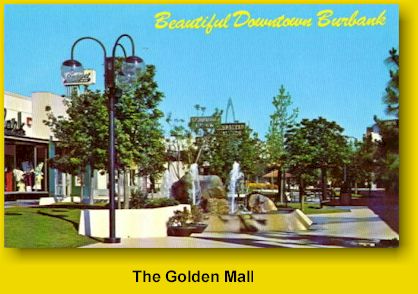 Needless to say, my interest in the occult exposed me to odd and unwholesome things. In 1970 the weekly magazine Man, Myth and Magic was introduced, and I was an avid reader. If my parents had realized that photos of naked and semi-naked women were sometimes used in the articles I'm sure they would have disapproved. After all, what parent would want his child looking at photos of a naked female dancer taking part in a voodoo rite involving beheading a sacrificial chicken? But my parents' intellectual relationship with me and my interests was always characterized by a mystified standoffishness on their part. "Why are you listening to that longhair music?" my poor mother would ask when I played classical music. Later, when I discovered David Bowie and Alice Cooper, the question became, "Why are you listening to that swing music?" Raising me must have been something of an ordeal.
Needless to say, my interest in the occult exposed me to odd and unwholesome things. In 1970 the weekly magazine Man, Myth and Magic was introduced, and I was an avid reader. If my parents had realized that photos of naked and semi-naked women were sometimes used in the articles I'm sure they would have disapproved. After all, what parent would want his child looking at photos of a naked female dancer taking part in a voodoo rite involving beheading a sacrificial chicken? But my parents' intellectual relationship with me and my interests was always characterized by a mystified standoffishness on their part. "Why are you listening to that longhair music?" my poor mother would ask when I played classical music. Later, when I discovered David Bowie and Alice Cooper, the question became, "Why are you listening to that swing music?" Raising me must have been something of an ordeal.
One night, as a sort of parlor game, I took my deck of tarot cards across the street to the Gardemanns' house to cast fortunes; I was fourteen. My friend Viki Gardemann was there, and so was her friend Louann, on whom I secretly had a crush. I greatly enjoyed the attention as I did tarot card spreads for various family members and the girls, and found myself adding elements of mystery in the readings for Viki and Louann. (I am certain this element of fortune telling is as old as the cards themselves.) I noticed, however, that the Tower of Destruction kept appearing in the layouts, and I predicted that some great calamity was near at hand. After I had extracted every iota of attention that I could from being Wes the Mystic, I left for home. The next morning, or the morning after that, I forget which, the San Fernando Valley was awakened by the powerful and destructive earthquake of February, 1971. Naturally, I lost no time pursuing a sort of mystic opportunism when I reminded the girls that I had predicted it. And I learned at age fourteen what every older charlatan knows: people only recall the one big prediction that came true, not the countless little ones that didn't.
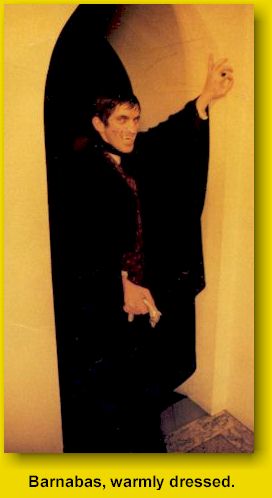 I got so heavily involved in the occult and mysticism that my nightly tarot readings became a formal ritual. I'd shut the bedroom door so I couldn't hear Dad's television show, turn off the garishly-colored swag lamps in my room, light some candles, sit cross-legged in a bathrobe on the sofa and shuffle the cards while my eyes were closed, preparing to lay the cards out on the table. One night Dad stepped in, and adopting his best Brooklyn persona, loudly demanded, "What are you? Some kind of goddamn monk or something?" (He was equally unimpressed with my later attempts to record my arrangements of favorite rock songs: "You sound like a Marine in pain.")
I got so heavily involved in the occult and mysticism that my nightly tarot readings became a formal ritual. I'd shut the bedroom door so I couldn't hear Dad's television show, turn off the garishly-colored swag lamps in my room, light some candles, sit cross-legged in a bathrobe on the sofa and shuffle the cards while my eyes were closed, preparing to lay the cards out on the table. One night Dad stepped in, and adopting his best Brooklyn persona, loudly demanded, "What are you? Some kind of goddamn monk or something?" (He was equally unimpressed with my later attempts to record my arrangements of favorite rock songs: "You sound like a Marine in pain.")
It didn't take me long to realize that my nightly tarot readings were unproductive and unpredictive. My life in junior high school was just not interesting enough to encompass romances, sea journeys, catastrophes and the occasional death on a daily basis. I drifted towards disbelief.
Still, watching Dark Shadows every weekday fueled my interest in the occult for a long time. I recall once sitting on my Schwinn Sting-Ray talking to Viki Gardemann, wearing a ski jacket in the middle of summer because I read that Barnabas Collins wore a Macintosh in all weathers. Unlike Barnabas, a cold-blooded vampire, I sweated profusely. Viki, noticing this, asked why I was wearing a ski jacket when it was hot. I only smiled mysteriously.
I must have been the biggest nerd in Burbank.
Dark Shadows was taken off the air in April 1971, and by then I had pretty much moved on to my next obsession: medieval English history and King Arthur (whom I was introduced to by Man, Myth and Magic). Soon I was memorizing the names of the Plantagenet kings with as much energy as I had formerly used to memorize the meanings of the tarot cards.
And I have never made a significant journey by sea.
Note: I mentioned above that I came up with the first pop culture tarot deck. I also invented the Walkman. In 1972, as I walked along the railroad tracks from Burbank Junction to Empire Avenue to pick up the family car after school, I reflected upon how nice it would be to have a small, battery-powered cassette deck connected to a small pair of headphones. I knew that headphones didn't require much in the way of amplification, and that a few transistors on a small circuit board would probably be sufficient. I figured the cassette mechanism and associated circuitry would probably be somewhat larger than a transistor radio. In 1972 I was 16. Sony introduced the Walkman to great acclaim in July, 1979 and revolutionized the way people listened to music. If only I had had the investment capital...

Given the Sav-On article above and other associated interests in my life, I think I have a valid claim to being what I call a "Proto-Goth."
Goth, in case you don't know, is a movement - mostly a youth movement - involved with the celebration of death, vampires, pale skin, Victorian styles, blackness and despair. (Or something like that - perhaps I misrepresent it. I just haven't kept up.)
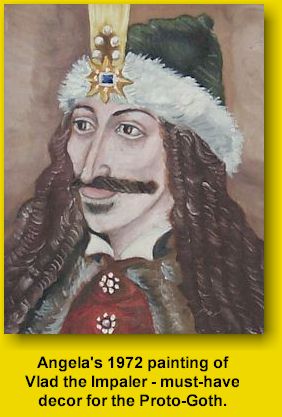 I claim I was a proto-Goth because the Goth movement didn't seem to get started until the late Seventies/early Eighties. It may have been helped along by the 1972 publication of Florescu and McNally's book In Search of Dracula, which Angela bought it for me. (At my request she copied one of the portraits from the book onto a piece of wood I bought at Standard Brands. Click here. My kids' friends think it's kewl, but my wife won't me hang it anywhere.) Also, Anne Rice's Interview with the Vampire in 1976 and the 1970's works of Stephen King probably helped, too. I know that after I had lost interest in comic books in about 1969, when I started reading books, supernatural themes and vampires became popular with D.C. and Marvel comics.
I claim I was a proto-Goth because the Goth movement didn't seem to get started until the late Seventies/early Eighties. It may have been helped along by the 1972 publication of Florescu and McNally's book In Search of Dracula, which Angela bought it for me. (At my request she copied one of the portraits from the book onto a piece of wood I bought at Standard Brands. Click here. My kids' friends think it's kewl, but my wife won't me hang it anywhere.) Also, Anne Rice's Interview with the Vampire in 1976 and the 1970's works of Stephen King probably helped, too. I know that after I had lost interest in comic books in about 1969, when I started reading books, supernatural themes and vampires became popular with D.C. and Marvel comics.
Here is evidence for my claim to be a proto-Goth:
1.) As described in the Sav-On article above, when I was thirteen I was deeply involved in the occult, mysticism, vampires, werewolves and the supernatural in general. I was even wading through imponderable works by leading occult writers like Alister Crowley (yikes!), whom I was introduced to by reading Man, Myth and Magic. However, I certainly cannot claim that I gained any eternal truths from this reading, and nowadays I'd just call it bunk. But looking back, it's pretty obvious why I had these interests: in 1964, when I was eight, there was a major fad in monsters of all kinds when the old Universal movies were shown on television. A few years later, in 1967, Barnabas Collins, the Dark Shadows vampire, was introduced to daytime television and a great nationwide following ensued. So it wasn't just me - in the late Sixties and early Seventies the occult was something of a general fad. Disneyland cashed into it in August, 1969 when they opened their Haunted Mansion. To this day it remains my favorite ride, and even riding it as a middle-aged man causes me to remember when Angela and I were obsessed with Dark Shadows plotlines.
2.) I was also interested in the writings of Edgar Allen Poe at this time, and read all of his stories. (I will admit, however, that I found myself merely scanning through the poems.) His short story Masque of the Red Death was a favorite; I had seen the 1964 Roger Corman film starring Vincent Price with my friend Jimmy, and it had sparked off an interest in Poe that I still have. I also appreciated and enjoyed the mood of corruption and despair that was a part of both the story and movie of Fall of the House of Usher. I also read some H.P. Lovecraft at this time.
3.) You might not realize this by reading the sunny and buoyant pages of Avocado Memories, but, in general, my literary, musical and cinematic interests have always been aligned with the darker and more despairing side of human experience. The latest form of this interest was in my 1999 discovery of film noir (1940's/1950's crime dramas). I love classical music, and ever since I first discovered it in 1974, my favorite opera is Alban Berg's depression-fest masterpiece Wozzeck. I also greatly prefer German expressionism to French impressionism. In spite of all this, however, I am almost always merry, cheerful and only rarely depressed - an inauthentic Goth.
4.) I have always enjoyed visiting especially picturesque cemeteries; the ancient New England kind with the old tilted tombstones and overgrown vegetation. The fact that there aren't any in Southern California simply meant that I'd have to wait until I moved to the East Coast to indulge this interest. The 17th century/early 18th century art of granite tombstone decoration is an interest of mine, and I get an artistic thrill when I see one of those primitively sculpted skulls with the angel wings. (I used to scribble them in my schoolbooks.)
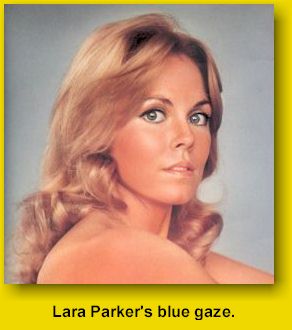 5.) My taste in women was somewhat different from others of my age. While Raquel Welch and Peggy Lipton ruled supreme, my fave was Lara Parker, who played the evil witch Angelique in Dark Shadows. I liked the other DS women in their stylish period dresses - with the exception of Grayson Hall, whom I thought was a major embarrassment as an actress - but those luminous blue eyes of Parker's fascinated me. (Nowadays my interest is always held by the film noir femme fatales, not the good girls.)
5.) My taste in women was somewhat different from others of my age. While Raquel Welch and Peggy Lipton ruled supreme, my fave was Lara Parker, who played the evil witch Angelique in Dark Shadows. I liked the other DS women in their stylish period dresses - with the exception of Grayson Hall, whom I thought was a major embarrassment as an actress - but those luminous blue eyes of Parker's fascinated me. (Nowadays my interest is always held by the film noir femme fatales, not the good girls.)
Obviously, any aspiring proto-Goth would have a major credibility problem living in Southern California - especially Burbank. The home of the Beach Boys and Jan and Dean is not a place necessarily conducive to obsessions regarding dissolution, death and decay. This dilemma was hilariously sent up in a past Saturday Night Live skit dealing with a Florida cable-access talk show, "Goth Talk." The hosts, a pale, undersized teenage boy and his similar-looking female friend, determinedly trooped on in the ways of darkness and despair despite jobs at local fast food franchises and a jock brother who interrupted broadcasts with taunts and, frequently, physical abuse. I enjoyed this comedy because I could relate to some degree. Another Burbank resident whom I sure could relate is Tim Burton, a 1976 graduate of Burbank High. Despite his crass San Fernando Valley surroundings he followed his dark muse successfully.
As for me, well, I got married and had kids. You never read about troubled, aristocratic family scions having to drive kids to and from school sports, drama productions and cheerleading practice. I certainly can't imagine members of the Collins family of Collinsport, Maine doing it - Barnabas at the wheel of a mini-van, for instance.
Note on images: The winged skull is a crayon rubbing I made late one night from an early 18th-century granite tombstone near Belmont, Massachusetts. I was delighted to realize that Paul Revere galloped by it in his famous night ride. You just don't get that combination of historicity and art in the San Fernando Valley! A photo of Lara Parker in period costume as Angelique is more appropriate for this article, but the one above is a stunner I just couldn't resist using. Click here for a comparison of Angela's painting of Vlad Dracula and an original. Pretty good, don't you think? Finally, thanks to Mike McDaniel for that 1973 image of Sav-On.